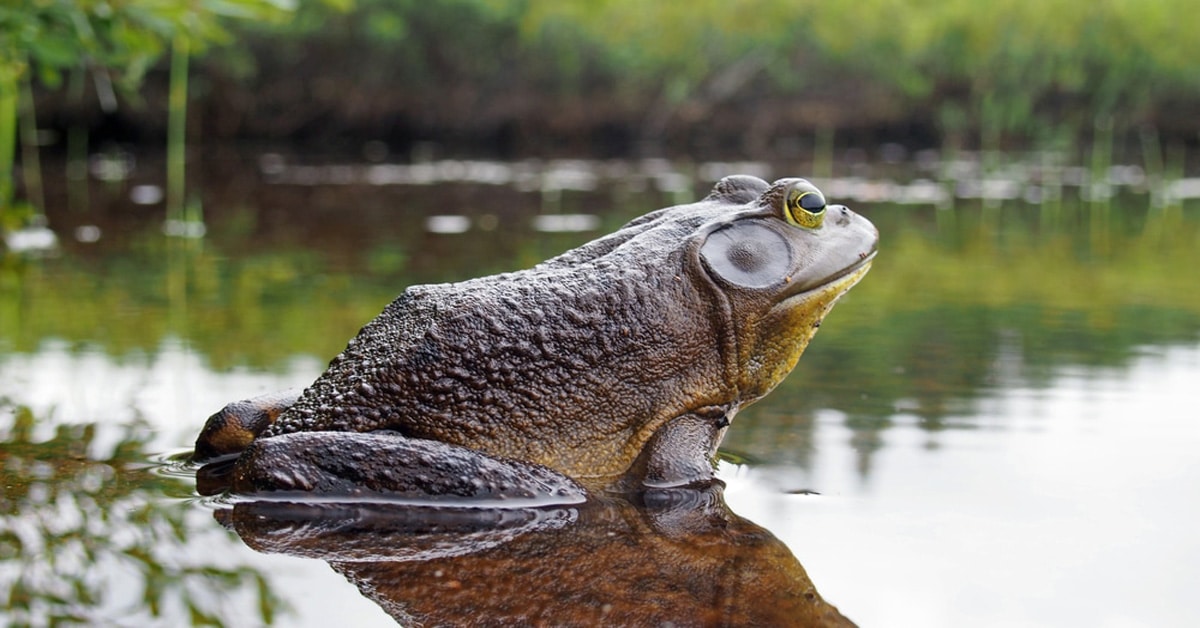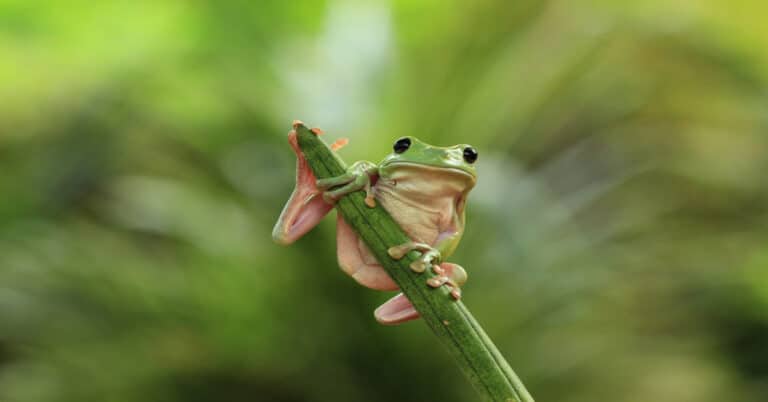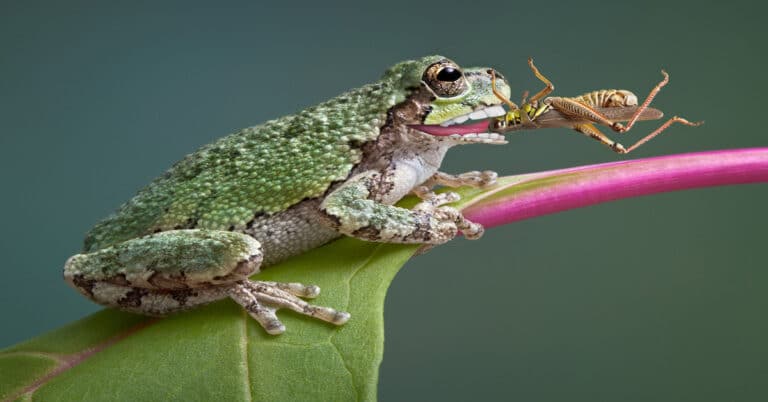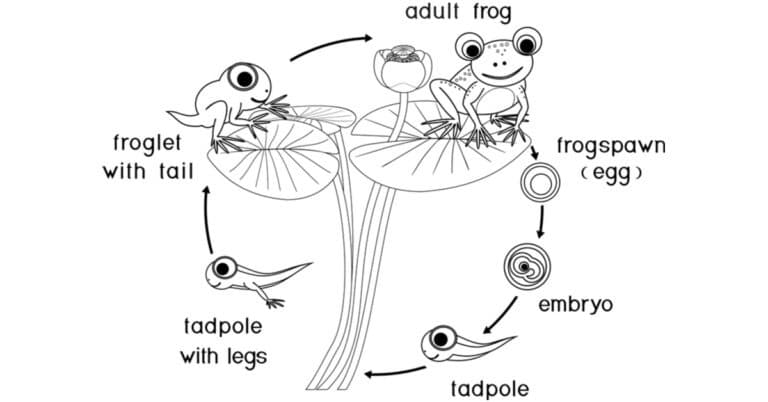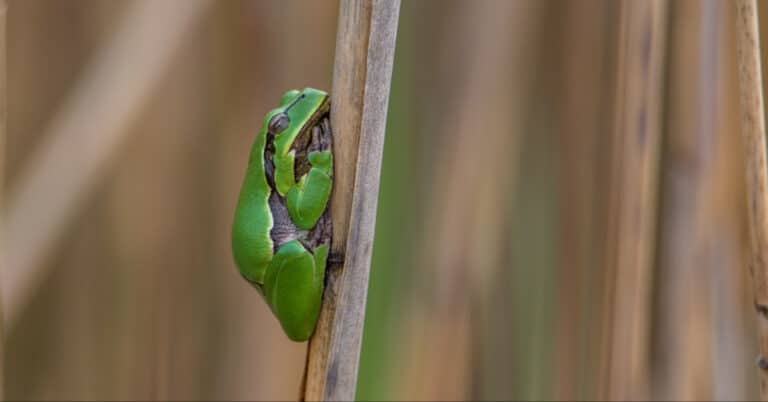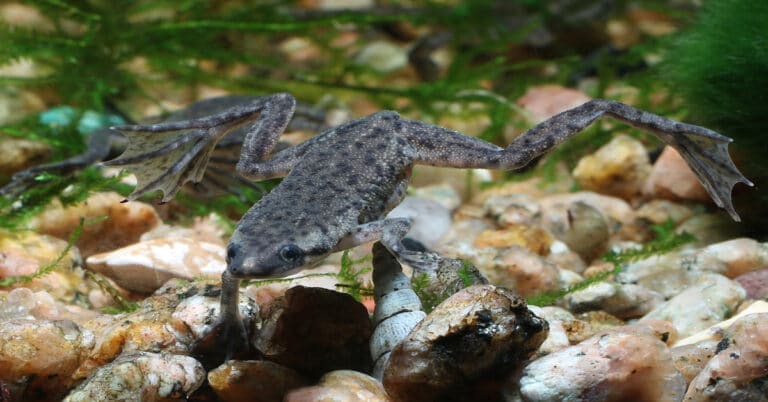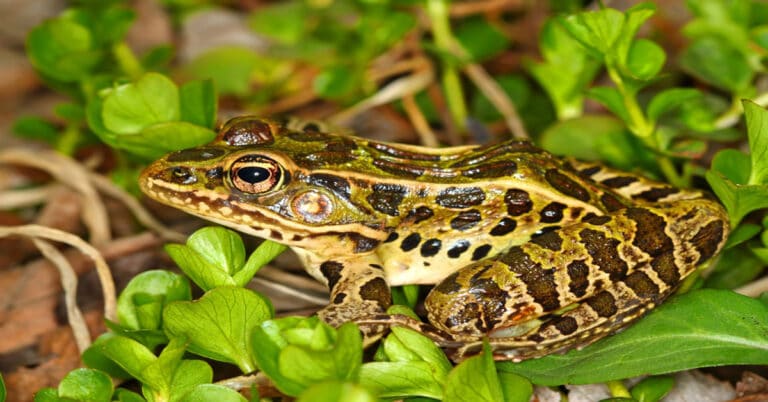American Bullfrog
The American bullfrog scientifically called Lithobates Catesbeianus, is generally known in the United States and Canada by the name bullfrog. This is a marine frog, associated with the Ranidae family or “real frogs”. This variety is customarily grouped as Frog Rana Catesbeiana, nevertheless, on account of paraphyly( where one group of organism separates from other groups at a particular point of common origin) in Ranidae, the grouping has been changed from the frog Rana Catesbeianus to Lithpobates Catesbeianus. The characteristic features of this frog are, its back is colored olive green with blotched markings of brown tint on its sides, and its belly is of white color having gray or yellow spots. Generally, their upper lips are colored brilliant green, and the throat of the males are colored yellow. They settle in big enduring water bodies, like ponds, swamps, and lakes. Generally, we find them at the borders of these water bodies. At the time of breeding, the male frog fiercely protects his territory. The call of the male is evocative of the roar of a bull, hence the name bullfrog. This frog is an inhabitant of the eastern regions of Canada and the United States. However, it has, to a great extent spread all over the regions of central, northern, and southern America, several parts of Asia, and The western regions of Europe. In certain regions, it is considered an invasive species.
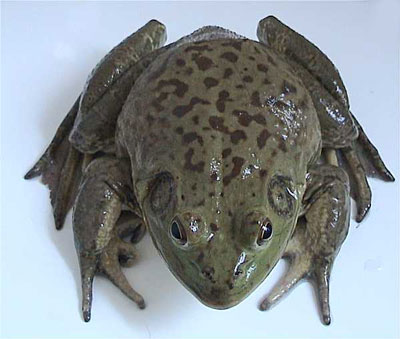
Scientific Classification
| Kingdom | Animalia |
| Phylum | Chordata |
| Subhylum | Vertebrata |
| Class | Amphibia |
| Order | Anura |
| Family | Ranidae |
| Genus | Lithobates |
| Species | L. Catesbeianus |
| Binomial name | Lithobates catesbeianus |
Other Uses of Bull Frogs
In North America and other countries, harvesting of the bullfrogs is used as a food product, where they were initiated. Besides culture of this is also done where the environment is controlled, even though this practice is cumbersome and often a failure. International trading of frog legs is done to a certain extent for human food. Apart from this, in schools, it is used for dissection in biology classes. Occasionally some keep them as pets, even though it is not advised.
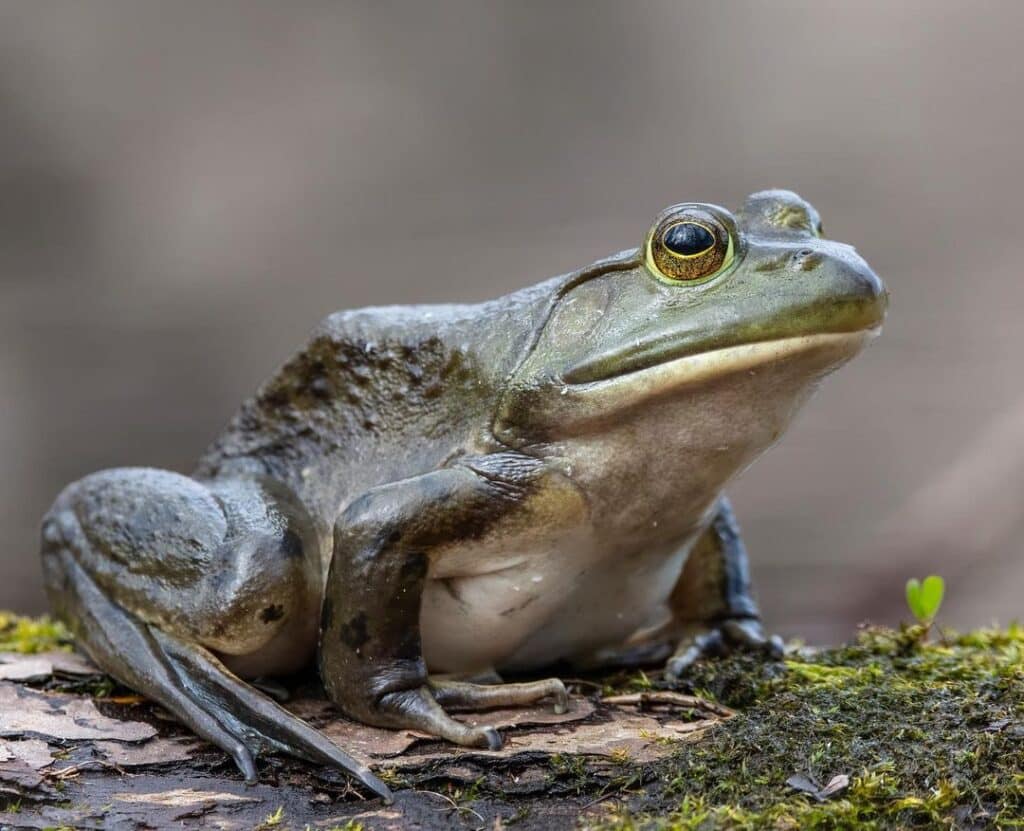
Anatomy
The eardrum (scientific name tympanum) of the female is the same size as that of its eye, whereas those of the males are bigger.
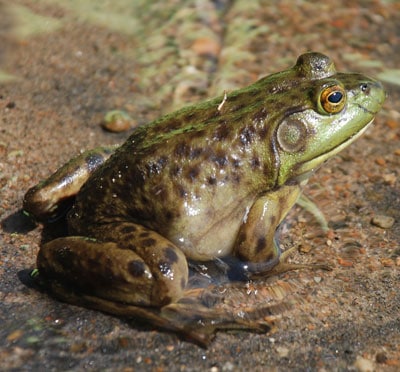
In North America, the biggest frog is the Bullfrog. The development of the females is bigger than their males. Which is till 8 inches? The color of the bullfrog varies from dull green to deep olive on its back and on its underside, form cream to white below. Their hind legs normally have gray color mottling Splotches).
The ear drum of the female bullfrogs is small in size, situated behind their eyes it is either same size or smaller than their eyes. Whereas that of the males is bigger, even larger than their eyes, this differentiates the female from the male.
The tadpoles of the bullfrog, survive till 2 years prior to becoming frogs. The size of the frog depends on the time they remain as tadpoles.
The color of the eyes is either brown or gold in color, their head and body is broad and flat. The average length of the body to which they grow is almost 31/2 to 6 in to 15 cm). (However, records show that few grow to even 8 inches) and their legs sum up to lengths of 7 to 10 inches (17 to 25 cm).
It is possible for you to differentiate a bullfrog from the other pig frog or Green frog by their deficiency of dorsolateral ridges, which are two long lines on the majority of the frog’s back.
Infrequently we see frogs from the South as spotted. They have brown or golden eyes and their bodies and head are broad and flat. The average length of the body to which they grow is almost 31/2 to 6 in (9 to 15 cm). (However, records show that few grow to even 8 inches) and their legs sum up to lengths of 7 to 10 inches (17 to 25 cm).
Behavior
Bullfrogs are lonely (live alone) creatures, they are more to the land. They hardly get together other than to quarrel for land or for mating. It is in the spring season that bullfrogs mate.
The matured bullfrogs mostly remain adjacent to water. They dwell in lakes, ponds and streams where the water movement is slow. They stay around the banks of rivers or at the border of water columns. If you scare them, there is possibility that they jump in the water, if not, hide themselves on the shore between plants, bullfrogs normally conceal themselves among tall plants, like cattails or perhaps between the lily-pads. They are fond of camouflaging their prey. They are nocturnal.
The Bullfrogs are expert swimmers, paddle with their muscular hind legs. The webbed feet of their hind legs assist them in this. The bullfrog lies dormant during winter, habitually getting buried in the mud. The call of the bullfrog is loud and with depth, which is heard around a quarter of a mile.
The other way round, the matured Bullfrogs consume snakes-There are instances where garter snakes (that are normally have frogs as their prey) are seen in the stomachs of the Bullfrogs. Besides, wounded snakes are at times seen adjacent to ponds where bullfrogs dwell. The leap of the bullfrog reaches almost 2 m or 10 times the length of their bodies! Bullfrogs protect their province by means of a typical call, in case that doesn’t hold well, either by pushing, kicking or even wrestling.
Habitat
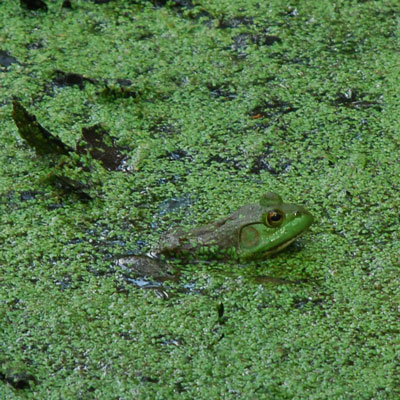
One among the supposed “real frogs”, Bullfrogs are normally greenish-brown to green in color. The habitat of these frogs is the eastern regions of the United States, which ranges from the extreme North to the Nova Scotia, right through Central Florida. Besides, their habitat even extends to the Western regions like the Rockies and Wisconsin, where they were initiated in a wide area all over the British Columbia, Colorado, California and many western countries.
These frogs dwell in the plant life all along the borders of large fresh water bodies of gradual movement.
The bullfrogs are very helpful around the places where they come about in nature by limiting the population of insects and mosquitoes. Whereas in areas where they have recently been initiated they consume that much which ultimately wipe off the native variety of frogs over there.
As a Pet
Breeding
Around 25,000 tiny eggs are laid by the female bullfrog that are clustered jointly and float on the top of the water. In the end when they are hatched, these tadpole bullfrogs continue to stay in that particular phase for around 2 years! The scientists remark that the size of the frog is determined by the length of the time they remain as a tadpole. The bigger the better and it will have a longer life.
Housing
Quite different from the many Herp, such as snakes and alligators, frogs possess the great capability of adapting to varied circumstances. Irrespective of whether they are reared in a big tank or if they were taken care of in an outside pond, they survive for a long time. For fabricating a perfect terrarium with all the convenience in a suitable atmosphere, you need to think a little. The following paragraph is meant for you to take the right decision on the ideal tank for your frog.
The natural habitat has a lot to do regarding the housing for your frog. Make the front portion of your frog’s tank to remain waterproof, because frogs, quite different from the other reptiles get hurt easily when they jump towards the walls of their new home, it is suggested that to purchase an aquarium from a pet store and not fabricating one on your own, (if at all you are experienced in fabricating glass terrariums). Aquariums particularly meant for fish are available in the pet stores in large quantities. By all means the ideal setup is having a pond in your area; this depends on your luck to reside in a place where frogs are available. In case you have decided to build one of your own, here are some guidelines:
Those amphibians that are available in the catalogs of pond supply that are meant for ponds normally are not indigenous. Most awful cases are the small tadpoles which develop as Rana catesbeiana, bullfrogs. Bullfrogs consume any moving thing that fits into its mouth, inclusive of even the frogs in danger of extinction, as well as the indigenous ones. Be on your guard when purchasing frogs in your region, since the consequences are shocking! You better go with the age old saying: “If you build it, they will come!”
Of course in any case you possess a pond in your vicinity try avoiding using pesticides.
Food
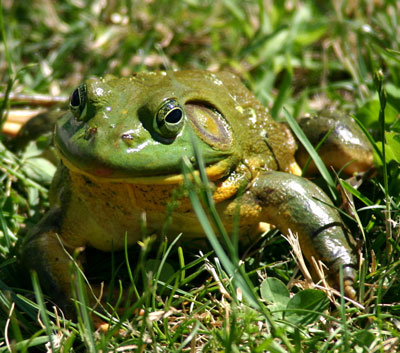
Bullfrogs are insatiable eaters (consume a great deal), they devour anything that is possible to gulp down. They are crayfish, minnows, worms, insects, young birds, little mammals, tiny turtles and other kinds of frogs (also bullfrogs) and snakes.
This is when it becomes dangerous for my interest. These fellows possess a ravenous desire for food and at the same time consume whatever they can gulp down inclusive of little vertebrates and invertebrates like fish, turtles, and other kinds of frogs, birds, reptiles and mammals. Bullfrogs possess teeth on the ceiling of their mouth; their tongue is muscular which has the capacity to flip the prey in their mouth. They consume plenty and plenty of actual big sized bugs, fish (I am informed that guppies are not bad as food) and also mice, almost everything that enters their mouth. Leave alone the big sized worms and insects on top of the rocks, although they eat them on top of water also. Offer them killed mice with the help of forceps (yet again, obtain the variety having rounded balls at the tip so as not to take the danger of hurting them when they pounce on the food item). The general recommendation is that to keep these bullfrogs unaccompanied (only to breed) in order to evade savaging.
Strange Facts About Bull Frogs
- In case you have a pond in your vicinity, you are sure to come across a bullfrog. One can recognize a bullfrog by the noise it makes. The profound calls suggestive of the mooing sounds of the cattle, this gave it the name “bull” frogs. Even though bullfrogs are of great advantageous in curbing pests and mosquitoes, exporting them to outside countries have been a threat to the varieties of frogs in the country.
- The normal color of the American Bullfrog ranges from olive green, green to brown or even gray. Its skin is uneven and has a coating of dark colored patches or perhaps spots that assists them in camouflaging.
- The eye of the American Bullfrogs is colored golden, its tongue is long and sticky, and on either side of their head they have circular eardrums. It is these organs that make it possible for them to identify the prey and bring victory in hunting.
- The name Bullfrog comes from the mooing sound produced by the male frog. The sound produced is so loud, that it is heard across ½ a mile. It is during the mating season that the male vocalizes.
- These American bullfrogs are agile at night time (they are nocturnal creatures). It hangs around quietly till the prey approaches it and surprisingly pounces on them. (Just like an ambush predator).
- The skin of the Bullfrog is toxic with a foul smell, thus it has less enemies in nature. Raccoons, turtles, snakes and birds of prey are the American bullfrog predators
- It is in winter that these American Bullfrogs lie dormant. They conceal themselves in the mud and wait for the weather to be better.
- Males live more on the land and act rough towards the impostor.
- These American Bullfrogs live up to 10 years in nature and when in captivity, they survive even till 16 years.

Having discovered a fondness for insects while pursuing her degree in Biology, Randi Jones was quite bugged to know that people usually dismissed these little creatures as “creepy-crawlies”.

